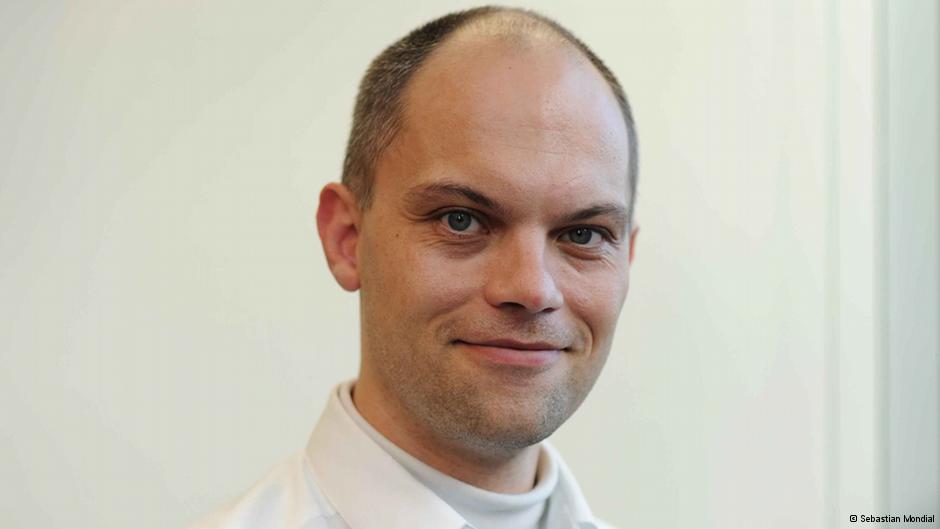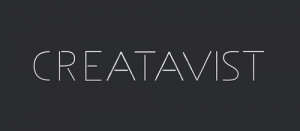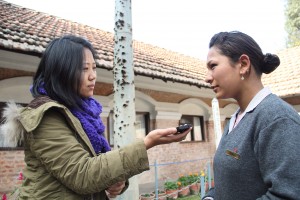People who innovate: Syria Deeply founder Lara Setrakian
 Seasoned reporter Lara Setrakian quit a coverted job as a Middle East correspondent to co-found the online news site, Syria Deeply. The portal is dedicated to a single topic – the conflict in Syria – and has an innovative approach to news gathering. It serves as a landing page for pertinent news on the conflict, combining original reporting from the field with aggregated material. It also includes a plethora of digital storytelling tools from interactive maps and timelines to SoundCloud commentary and tweets.
Seasoned reporter Lara Setrakian quit a coverted job as a Middle East correspondent to co-found the online news site, Syria Deeply. The portal is dedicated to a single topic – the conflict in Syria – and has an innovative approach to news gathering. It serves as a landing page for pertinent news on the conflict, combining original reporting from the field with aggregated material. It also includes a plethora of digital storytelling tools from interactive maps and timelines to SoundCloud commentary and tweets.
Setrakian left her cushy TV job (her words) with Bloomberg and ABC News because she felt the mainstream media coverage of the Syria crisis was difficult to follow with chaotic storylines instead of thorough reporting on the war and its humanitarian consequences.
In an interview with onMedia’s Jannis Hagmann, Setrakian talks about how she wants to fuse traditional journalism with startup culture and reform the coverage of global crises.
![]() read more
read more
Taking your radio features to the next level (part 1)
Radio journalists who regularly produce features can get stuck in a rut or develop bad habits. After a while, their work can start sounding a little formulaic. In this two-part post, radio producer and trainer Kyle James offers advice on putting a bit of zing back in your features and taking your audio packages one step further.
![]() read more
read more
Secure collaboration among journalists: tips from an expert
 Sebastian Mondial was one of the first journalists entrusted with millions of leaked offshore tax files. Because of the sensitive nature of the information – which involved the secret financial transactions of individuals from corrupt politicians and international arms dealers to millionaires and middle-class professionals – secure communications among those involved in the investigation was of the utmost importance. The ensuing collaboration, involving nearly 100 journalists from 40 countries, was probably the largest in journalism history
Sebastian Mondial was one of the first journalists entrusted with millions of leaked offshore tax files. Because of the sensitive nature of the information – which involved the secret financial transactions of individuals from corrupt politicians and international arms dealers to millionaires and middle-class professionals – secure communications among those involved in the investigation was of the utmost importance. The ensuing collaboration, involving nearly 100 journalists from 40 countries, was probably the largest in journalism history
Mondial was pivotal in setting up the communication channels and ensuring that the information exchange avoided surveillance. In the following guest post for onMedia, he gives some tips on how to protect communications from snooping eyes while still keeping the information flowing.
![]() read more
read more
Tools & Apps for Journalists: If This Then That

If This Then That (commonly known as IFTTT, pronounced ‘ift’, like the word ‘gift’) is a neat little online tool that can magically simplify your online activities by automating tasks. It’s based on the idea of “if this happens, then do that”. When I publish this post on WordPress (the ‘if this’ part), I can use IFTTT to automatically post the link to my Facebook account (the ‘then that’ part). Or else, every time I like a track on SoundCloud, I can get IFTTT to download it automatically to my Dropbox.
IFTTT supports a whole bunch of online applications (including all the major ones). The tool works by simple rules so that each specific event triggers a specific action. IFTTT calls these rules ‘recipes’. Once you have granted IFTTT access to the apps you use, you can create your own individual recipes.
IFTTT walks you through the process step by step and it’s really easy to use.
![]() read more
read more
Trainer recommendation: Mozilla Thimble
![]() If you’re looking for a simple way of introducing your online journalism trainees to the web’s Hyper Text Markup Language, better known by its acronym HTML, then consider the nifty little Mozilla Thimble editor – part of Mozilla’s suite of Webmaker tools.
If you’re looking for a simple way of introducing your online journalism trainees to the web’s Hyper Text Markup Language, better known by its acronym HTML, then consider the nifty little Mozilla Thimble editor – part of Mozilla’s suite of Webmaker tools.
![]() read more
read more
DW Akademie panel discussion in Berlin: Digital Safety for Journalists
Everything from the very real threats journalists face from internet surveillance, to losing control of personal data through mobile messaging applications were all canvassed at DW Akademie’s Digital Safety for Journalists panel discussion at the ARD-Hauptstadtstudio in Berlin.
Joining DW Akademie’s Holger Hank on the panel were Anne Roth (Tactical Technology Collective), Zahi Alawi (DW Akademie), Malte Spitz (German Greens Party), John Goetz (NDR) and William Echikson (Google).
Along with discussing the need for media organizations to be proactive and train journalists to use encryption and secure digital communications, the data retention policies of governments and technology firms, and how the internet should be controlled were also lively debated.
![]() read more
read more
John Goetz: “Secret services don’t work well”
 It was a few blurred spots on Google Maps that sparked the curiosity of investigative journalist John Goetz and his colleague Christian Fuchs. They wondered what was being hidden in Germany from the public eye. Several years of in-depth research later, they had their answer: they discovered US agencies were coordinating part of the war on terror from German soil, including the drone war against Africa.
It was a few blurred spots on Google Maps that sparked the curiosity of investigative journalist John Goetz and his colleague Christian Fuchs. They wondered what was being hidden in Germany from the public eye. Several years of in-depth research later, they had their answer: they discovered US agencies were coordinating part of the war on terror from German soil, including the drone war against Africa.
Goetz, who currently works for the German public broadcaster NDR and the Süddeutsche Zeitung newspaper, has continually come up against secret services in his investigations. He helped expose the locations of CIA secret prisons in Europe as well as the secret service bumbling that led to the US using false intelligence from the Iraqi defector known as “Curveball” (who still lives in Germany) to justify the Iraqi war. “The essence of journalism is to show if a country is living a national lie” is one of Goetz’s mottos.
In his most recent coup, Goetz met with one of the world’s most wanted men, NSA whistleblower Edward Snowden. And despite, or perhaps because of his investigations into the activities of the US secret services, Goetz has a relaxed attitude to potentially being under surveillance.
“Secret services don’t work well,” he says in an interview with onMedia.
![]() read more
read more
Journalists@Work: Bhrikuti Rai
Bhrikuti Rai is a journalist at the English-language Nepali Times, a weekly publication based in Kathmandu. The 25-year-old completed an undergraduate course in Media Studies at Kathmandu University, but says her real education began when she started working, learning from fellow journalists in the field and in the newsroom.
While she covers politics and business, for the past several years she’s expanded her beat to include the environment — an issue of critical importance for mountainous Nepal, which is highly vulnerable to the effects of climate change. Bhrikuti recently participated in a regional workshop on environmental reporting in Chennai, India, and was selected to attend the UN Climate Change Conference in Warsaw in November 2013.
![]() read more
read more
Making broadcasting more social

photo: flickr/Affiliate
For too many broadcasters, social media still remains something of an afterthought. A producer might promote an upcoming program on the Facebook page or send out a tweet. But really, much more can and should be done. These days, social media needs to be part of the entire broadcast production process.
![]() read more
read more
Tools and Apps for Journalists: Creatavist
What is Creatavist?
 Creatavist is a web-based storytelling platform developed by the media and software company The Atavist. Since 2009 The Atavist has used its Creatavist platform to produce and publish original long form narrative stories for the iPad. Now available in open beta, Creatavist offers tools for a variety of digital projects – from producing online books, magazines and video projects to even building your own app (as did the Paris Review and TED Books).
Creatavist is a web-based storytelling platform developed by the media and software company The Atavist. Since 2009 The Atavist has used its Creatavist platform to produce and publish original long form narrative stories for the iPad. Now available in open beta, Creatavist offers tools for a variety of digital projects – from producing online books, magazines and video projects to even building your own app (as did the Paris Review and TED Books).
However, the most interesting feature of Creatavist for journalists might be the possibility of creating online multimedia specials that make use of parallax-scrolling effects – or short Scrollitelling as Benjamin Hoguet, co-founder of Djehouti (the company behind the storytelling software Racontr) likes to call it.
 The acclaimed Snow Fall by the New York Times is probably one of the most popular and most praised “Scrollitelling” projects. However, since its publication, a lot of other multimedia stories have popped up, such as Killing Kennedy by National Geographic or the recently published NSA files decoded by The Guardian – just to name a few. Even though these specials are impressive, it is not as hard as one might imagine to create projects comparable to those mentioned. And using Creatavist combined with a bit of time and patience is definitely a good way to start.
The acclaimed Snow Fall by the New York Times is probably one of the most popular and most praised “Scrollitelling” projects. However, since its publication, a lot of other multimedia stories have popped up, such as Killing Kennedy by National Geographic or the recently published NSA files decoded by The Guardian – just to name a few. Even though these specials are impressive, it is not as hard as one might imagine to create projects comparable to those mentioned. And using Creatavist combined with a bit of time and patience is definitely a good way to start.
![]() read more
read more










Feedback